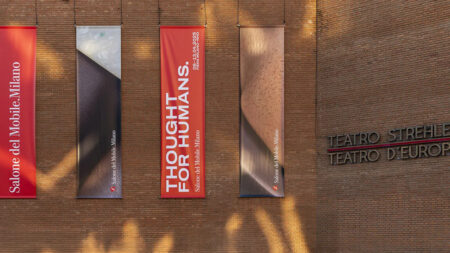London is an emotion. It’s a dream destination for travel enthusiasts, a Mecca for tennis lovers, and a treat for food aficionados. There is something for everyone to cherish in the city, and in the pulsating heart of London lives a man who gave the ‘Old Smoke’ its moment in time. The year was 2003, and as the Sun dawned over London’s iconic skyline, Ben Evans (CBE) embarked on a journey to ink London on the global design map.
Together with co-founder John Sorrel ‘The London Design Festival’ kicked off in 2003 and gradually grew into a yearly affair for the city’s creative landscape. The duo recognized the need for a dedicated platform to showcase London’s multifaceted design prowess. “The event was very modest at the beginning. We were an unknown quantity at that point. Sometimes we had to literally beg people to do stuff,” Evans narrates the hardships during the initial years of what’s now a flagship event.
“We had 35 projects in the first year, and within four years we had 300, so it reached a maturity very quickly,” Evans mentions. Over the decade though, the festival swiftly burgeoned into a global phenomenon, attracting millions of visitors from London, UK, and across the globe. As the festival cherishes its third decade, Homecrux caught up with Ben Evans for an exclusive interview, where we delve into his personal and professional journey.
“This city has got kind of breadth and depth,” Evans states in a philosophical tone. “What I mean by that is that London has excellence in 15 to 20 different design disciplines. The subject of design is much bigger than one might imagine, so often cities have excellence in two, three, or four sectors, but London has excellence in 15 plus. So we wanted to celebrate that kind of diversity in design, and as a result, we kicked off the festival in 2003,” he states.

What Evans and Sorrel envisioned bore fruit when in 2019 the Festival welcomed a record-breaking 600,000 individual visitors from over 75 countries. Since it has played a crucial role in the growth of the design industry, bolstering London’s position as a global destination for business, culture, and tourism. While we continue to accredit Evans for the event, it is to be noted that he had no intention of being a designer or a curator. Evans rather enjoyed watching cartoons and football in his early childhood.
Evans confesses his lack of interest in cricket but eagerly professes his deep-rooted love for football. A ‘Gooner’ by heart and head, his allegiance to Arsenal FC traces back to familial ties and childhood memories of living near their grounds, where the exhilarating roar of a goal echoed through the local park.
Born and bred in the heart of London, Evans’ early exposure to design and architecture however began when he attended a lecture by veteran architect Richard Rogers. “I was about 15, and my mother told me, she was going to take me to a lecture. And I thought, oh God, a lecture that sounds boring. I don’t want to go to that. I want to watch my favorite program on TV, and anyway, she dragged me to this lecture,” he recalls.
Evans had no option but to sit in there and hear what Richard Rogers had to say about the most famous and radical buildings of that time, Centre Georges Pompidou. “I sat there looking at him thinking, wow, he’s quite cool and the building was amazing. It was a formative experience because I developed an interest initially in architecture and then from that to design,” he informs.
Another pivotal moment that caught Evans’ attention toward design came when he encountered the seminal work of design historian Nikolaus Pevsner. “After hearing Richard Rogers, I started to buy books and read about it. Once my family heard I was interested in reading, this became a ‘Christmas Present’ kind of thing. One of the initial books I got was penned by the great art and design historian, Nikolaus Pevsner. And the book was called Pioneers of Modern Design. Since I was particularly interested in 20th-century early modernity, I devoured this book.”
“As I went to the school after the holidays, there was a boy in my class whose surname was Pevsner. It was quite an unusual surname, so I said to him; I got this book by a guy called Nikolaus Pevsner. He said, oh, he’s my grandfather. Would you like to meet him?”
Evans went to have tea with Pevsner, who was at the fag end of his life, at his house in Hampstead in North London. “He was so sweet and charming, and was pleased that I’d read his book and wanted to know what I thought, for the subject,” Evans narrates his outing.
These two experiences stirred an emotional wave within the Londoner and led to his lifelong interest in architecture and design. Initially drawn to the study of architecture, Evans soon realized his true calling was in the history of design. His academic pursuits led him to the Royal College of Art, where he delved into the intricacies of design evolution, “which was in those days the only academic subject at the college.”
One thing led to another and Evans ultimately found himself writing policy for the Labour Party which was then in opposition. He researched and drafted their first design policy which came out before the 1992 election. “So it evolved very quickly into, more of a professional career,” he points.
With the London Design Festival in its third decade, Evans remains steadfast in his mission to support design as an agent for innovation and social engagement. “We’re at an early stage of a year in our planning. We’ve got some ambitious projects that we will be launching this September, but that’s part of my cyclical life. We don’t want to stand still as an event. We want to be different each year. So we’re constantly trying to be aware of changes in behavior and innovations in technologies that we can integrate into our daily lives.”
Without disclosing much, Evans points out, “We’ve got a platform on which sits a lot of content. And what we’ve also got is a hungry audience wanting to consume that content. I think our tendency is to go and experience things we already know about, but the most rewarding is to go to discover something new. But they need our help to do that, and we want you to go into new areas, see things in those areas by people you’ve never heard of, and be kind of brave in your choices and your consumption. So we’re trying to kind of help our audience.”

Evans underscores the pivotal role of design in demystifying complex technological advancements, from quantum computing to the Metaverse. Drawing on examples from leading design firms like Barber Osgerby; Evans elucidates how designers are collaborating with tech giants to envision and shape the future of computing.
“Whether it’s designing furniture for quantum computing labs or conceptualizing immersive virtual worlds, design serves as a critical lens through which we navigate and understand the intricacies of technology.”
The 60-minute long interview provided ample discussion points and as the conversation veered toward sustainability, Evans sheds light on an array of topics including a notable shift toward sustainability within the design landscape. “Over the past five to seven years, there has been a palpable transformation in both design practices and consumer preferences with sustainability emerging as a central ethos,” he points out.
Drawing parallels with Milan, another design powerhouse, Evans delineates critical disparities, emphasizing London’s unique focus on idea expression alongside product showcasing. “Unlike Milan’s Salone del Mobile, renowned for its commercial emphasis, the London Design Festival is characterized by its diverse array of ideas, fostering a multifaceted celebration of creativity,” he states.
As dusk descends upon the city, Evans’ day culminates in moments of reflection, gratitude, and anticipation for the myriad possibilities that tomorrow may bring, while watching Arsenal fight for the top spot, and sipping better wines through the course of his life.
Follow Homecrux on Google News!




